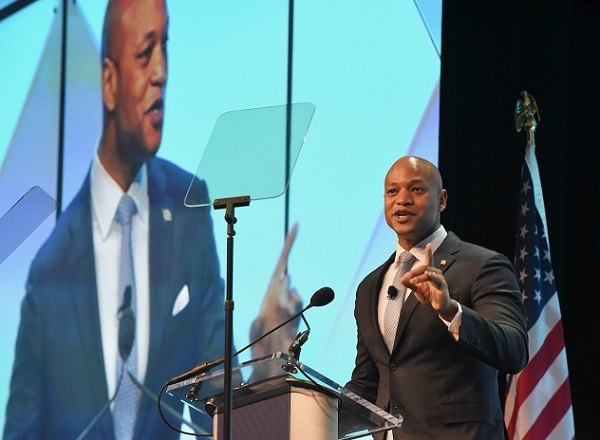ANNAPOLIS, MD—Governor Wes Moore on Wednesday announced major offshore wind energy initiatives to move Maryland toward achieving its “100% clean energy” goal by 2035.
Governor Moore announced that Maryland will significantly increase its offshore wind output and prioritize wind energy partnerships to position Maryland to be the country’s leader in offshore wind production.
“Here in Maryland, we can have both a growing economy and lead the way in clean energy,” said Governor Moore. “Maryland is rich in natural assets, institutional strength, numerous offshore wind energy partnerships and a thriving workforce–and I believe if we work together, our state will lead the country in offshore wind energy production.”
The governor presented his vision during a plenary keynote this morning at the International Offshore Wind Partnering Forum in Baltimore. The forum is the premier annual offshore wind energy conference in the Americas, connecting global leaders, businesses and industry experts to discuss technology, policy, and vision for the future of offshore wind.
To move Maryland toward achieving the goal of 100% clean energy by 2035, the governor announced that Maryland will aim to quadruple the amount of energy produced by offshore wind from about 2 gigawatts to 8.5 gigawatts of power, which is enough to power nearly three million homes. To support the effort, the administration is working to establish new lease areas and strengthen the offshore wind supply chain.
Governor Moore is also elevating a key partnership between U.S. Wind and Tradepoint Atlantic to build an offshore wind manufacturing yard at Sparrows Point in Baltimore at the location of the former Bethlehem Steel plant. Orsted has committed to using Tradepoint Atlantic as a logistics hub to assemble advanced foundation components for offshore wind turbines using materials produced on the Eastern Shore at Crystal Steel. The partnerships will create nearly 15,000 jobs.
“The clean energy industry represents tremendous economic benefit for Maryland and it is important we have a strategy in place to not only grow our existing companies, but create a business climate that attracts new clean energy companies and global investment,” said Maryland Department of Commerce Secretary Kevin A. Anderson. “Working one-on-one with this industry, we will better understand their challenges and opportunities, and help them thrive in our state.”
To accelerate Maryland’s transition to a clean energy future, the governor also announced that the Maryland Department of Commerce has created a dedicated position that will ensure industry access to an array of state resources and create an environment conducive to startups, attracting investment and assisting established firms with growth, expansion, and workforce development. The Maryland Energy Administration will also focus on delivering more grants to companies that form key connections along the offshore wind supply chain, including those that develop turbines, blades, cables, and other mechanical parts.
“This is a code-red moment in our fight against climate change, and offshore wind will be at the center of our work to supercharge the renewable energy transition,” said Maryland Energy Administration Director Paul Pinsky. “We need to join forces across communities, states, and countries to invest in this emerging industry – and Maryland will be the headquarters of that work. I applaud Governor Moore for his leadership in this arena. He knows, as I know, that the stakes are too high for us to fail.”
Wind energy comes with its fair share of criticism, however.
Technology business leader and acclaimed strategist Steve Herbert points out that wind turbine blades have a life-span of less than 20 years after which they are replaced and cannot be recycled.
“Today, in Europe, over 3,000 blades are buried in landfill each year and this number is set to increase significantly as the UK, Belgium, France and the Netherlands have all indicated they will grow their offshore wind farms exponentially,” Herbert says. “In the US about 8,000+ blades are buried every year —and counting.”
“Once the blades are in the ground, they are there essentially forever as their indestructible materials do not break down over time,” Herbert adds. “Today, the number of blades disposed of in landfill is equivalent to burying 400 Airbus A380’s AND over 1,000 Boeing 747’s whole (the largest passenger planes in the world) —every single year!”
“Yes, (wind turbines) do not emit CO₂ but no, they are certainly not ‘renewable’ in any sense of the word.”
Do you value local journalism? Support NottinghamMD.com today.

